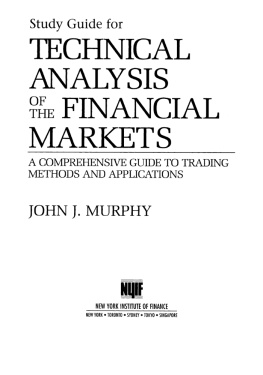T RADING WITH I NTERMARKET A NALYSIS
Founded in 1807, John Wiley & Sons is the oldest independent publishing company in the United States. With offices in North America, Europe, Australia, and Asia, Wiley is globally committed to developing and marketing print and electronic products and services for our customers professional and personal knowledge and understanding.
The Wiley Trading series features books by traders who have survived the markets ever-changing temperament and have prosperedsome by reinventing systems, others by getting back to basics. Whether a novice trader, professional, or somewhere in-between, these books will provide the advice and strategies needed to prosper today and well into the future.
For a list of available titles, visit our web site at www.WileyFinance.com .
T RADING
WITH
I NTERMARKET
A NALYSIS
A Visual Approach
to Beating the Financial Markets
Using Exchange-Traded Funds
John J. Murphy

Copyright 2013 by John J. Murphy. All rights reserved.
Published by John Wiley & Sons, Inc., Hoboken, New Jersey.
Published simultaneously in Canada.
No part of this publication may be reproduced, stored in a retrieval system, or transmitted in any form or by any means, electronic, mechanical, photocopying, recording, scanning, or otherwise, except as permitted under Section 107 or 108 of the 1976 United States Copyright Act, without either the prior written permission of the Publisher, or authorization through payment of the appropriate per-copy fee to the Copyright Clearance Center, Inc., 222 Rosewood Drive, Danvers, MA 01923, (978) 7508400, fax (978) 6468600, or on the Web at www.copyright.com . Requests to the Publisher for permission should be addressed to the Permissions Department, John Wiley & Sons, Inc., 111 River Street, Hoboken, NJ 07030, (201) 7486011, fax (201) 7486008, or online at www.wiley.com/go/permissions .
Limit of Liability/Disclaimer of Warranty: While the publisher and author have used their best efforts in preparing this book, they make no representations or warranties with respect to the accuracy or completeness of the contents of this book and specifically disclaim any implied warranties of merchantability or fitness for a particular purpose. No warranty may be created or extended by sales representatives or written sales materials. The advice and strategies contained herein may not be suitable for your situation. You should consult with a professional where appropriate. Neither the publisher nor author shall be liable for any loss of profit or any other commercial damages, including but not limited to special, incidental, consequential, or other damages.
For general information on our other products and services or for technical support, please contact our Customer Care Department within the United States at (800) 7622974, outside the United States at (317) 5723993 or fax (317) 5724002.
Wiley publishes in a variety of print and electronic formats and by print-on-demand. Some material included with standard print versions of this book may not be included in e-books or in print-on-demand. If this book refers to media such as a CD or DVD that is not included in the version you purchased, you may download this material at http://booksupport.wiley.com . For more information about Wiley products, visit www.wiley.com .
Library of Congress Cataloging-in-Publication Data:
Murphy, John J.
Trading with intermarket analysis: a visual approach to beating the financial markets using exchange-traded funds / John J. Murphy.
p. cm.(Wiley trading series)
Includes index.
ISBN 978-1-118-31437-1 (cloth); ISBN 978-1-118-41996-0 (ebk);
ISBN 978-1-118-43399-7 (ebk); ISBN 978-1-118-42158-1 (ebk)
1. Investment analysis. 2. Exchange traded funds. 3. Stocks. I. Title.
HG4529.M8625 2012332.6327dc23
2012020566
To chartists everywhere.
ACKNOWLEDGMENTS
I would like to begin by thanking Pamela Van Giessen, long-time Executive Editor at Wiley, for guiding me through several earlier books and for encouraging me to do one more. Her successor in that role, Evan Burton, convinced me that a new generation of e-books, with beautiful color graphics and digital enhancements, lent itself extremely well to visual market analysis, and would help bring intermarket analysis to a wider audience. Im glad he did. I would also like to thank Judy Howarth at Wiley for working so closely with me in the complicated task of putting the book together, and for making my part in doing that much easier. All of the charts in this book were done on the Stockcharts.com web site. I would like to thank the president of that organization, Chip Anderson, for creating new market indicators for my use in this book, and for providing historical market data that was extremely useful. Ive learned from many other writers over the years. Special mention is owed to Sam Stovall, chief investment strategist for Standard & Poors, for his work on sector rotation throughout the business cycle. Thanks also to John Creegan Jr. for his expertise in foreign exchange trading. Also to Ted Bonanno, my agent, who helped smooth the way. Finally, Id like to thank readers of my earlier books on intermarket analysis who encouraged me to write something more current on that exciting field. This book is for them. And, of course, for newer readers interested in intermarket analysis.
INTRODUCTION
M y first book on this subject, entitled Intermarket Technical Analysis: Trading Strategies for the Global Stock, Bond, Commodity, and Currency Markets (Wiley & Sons), was published in 1991. The reason I wrote the book was to demonstrate that all global financial markets are closely linked and have an impact on each other. The books main thesis was that technical analysts needed to broaden their chart horizon to take these intermarket relationships into consideration. Analysis of the stock market by itself, for example, was incomplete without taking into consideration existing trends in the dollar, bond, and commodity markets. That first book suggested that financial markets could often be used as leading indicators of trends in related markets or, at the very least, could provide confirmation (or nonconfirmation) of other existing trends.
Because the message of that earlier text challenged the single market focus of the technical community, some professional chartists questioned whether this newer and broader intermarket approach had any place in the technical field. Many questioned whether intermarket relationships existed at all or, if they did, whether they were consistent enough to provide any forecasting value. A paper on the subject that I once submitted to the Market Technicians Association (MTA) was rejected due to lack of proof. The seemingly revolutionary idea that all global markets are linked, and that American analysts could gain some edge by following trends in foreign markets, was also viewed with skepticism. How things have changed in the two decades since then.
Twenty years later, intermarket analysis is considered a branch of technical analysis and an increasingly popular one. A poll taken by the Journal of Technical Analysis asked the membership of the Market Technicians Association to rate the relative importance of various technical disciplines. Of the 14 technical disciplines included in the poll, intermarket analysis ranked fifth. In addition, my second book on the subject, entitled Intermarket Analysis: Profiting from Global Market Relationships (Wiley Trading, 2004), is now required reading for the MTAs Chartered Market Technician (CMT) programthe very program that rejected my earlier paper on the same subject. (The Chartered Market Technician program is a three-step certification process administered by the Market Technicians Association ( mta.org ) in which candidates are required to demonstrate proficiency in technical analysis. Successful candidates are awarded the professional designation of Chartered Market Technician.) It is certainly gratifying to see intermarket analysis come such a long way in the last two decades and to finally become such an accepted part of technical market analysis. After reading this book, I hope youll agree with me that intermarket analysis has also become an increasingly indispensable part of it.
Next page












